Summary
Well I've finished experimenting and I do not think I can improve
on the basic design.
Just to confirm my testing I will go for a long run,
taking a couple of days to roughly set it to the correct beat. The
result is reasonable acceptable in that the clock is at most 1.6 minutes
wrong at any instance and normally less than 1 minute wrong. The
plot below shows the run compared to a constant loss of 1.25
minutes, which I can now easily adjust using the verge dial.
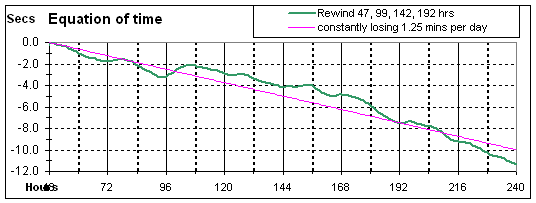
And this plot shows what happened hour by hour.
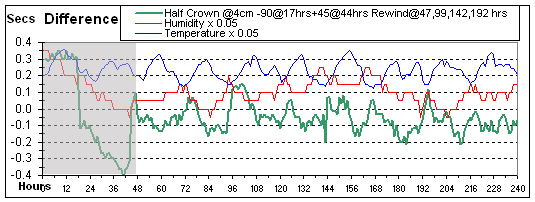
So
what I have wound up with is a wooden clock that is 10 times more
accurate than the original metal ones and also the one Clayton designed.
Although the clock is not as attractive as Clayton's, with the exception
of the arbors, fishing line and lead shot, it is made from bits and
pieces lying around the garage - so it is a green recycled clock!
It has been interesting that even with (careful?)
planning, the clock is quite different from my initial design and so I
shall describe each of the main elements of it below - to see how they
fit all together see my earlier
testing photo (although I have dropped the wine bottle in favour of
something more attractive!).
|
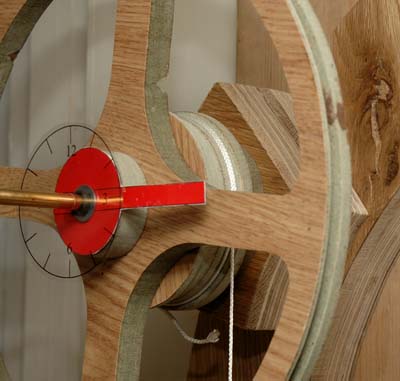 |
The main driving pulley is what I call a Leverage Pulley.
It has the advantage of less friction and allows one to be able to
have any power ratio you like, rather than be fixed as in the
conventional system. It also has less parts to make.
This is a real win-win design and I do not understand why more
people do not use this idea -
see my earlier page.
The Hour hand, and also the Minute one, are adjustable while the
clock is running by just moving them forwards or backwards.
They work by having a metal washing stuck to the hour & minute wheel
with the hands being made from thin fridge magnet material.
The (uncut as yet) arbor is mounted on a block to reduce its
bending.
The total weight is 6.5 lbs (Clayton suggests 5-6 lbs for a one
day clock), but it is currently geared for 2.5 days for the same
drop height - this is in part down to the advantages of the Leverage
pulley system. |
The Minute arbor consists of 3 elements (see
my earlier page), which are difficult to see - going from back
to front, they are...
- The winding drum, which is a polished curtain rod to allow the
winding rope to stay in position (while the clock is running)
without adding friction to the system.
- The actual drum, which should have been made from one piece of
wood as the fishing line use to easily slip into the joins.
The drum has the pawls attached to it.
- Lastly the minute wheel with the ratchet attached to it. The
pawls should be held against the ratchet as softly as possible, so
as not to upset the clock (with vibrations) during winding.All
arbors have O-rings and wee metal washers to keep the wheels in
position. |
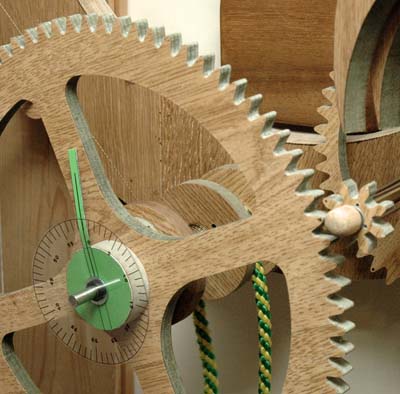 |
|
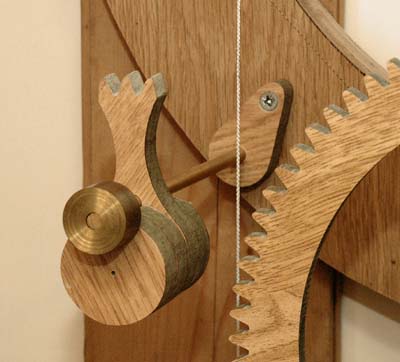 |
The Maintainer is a simple toothed weight to keep the clock
ticking during winding and will naturally fall off if one forgets
(as often as not) to remove it. One disadvantage of having this
(in the current frame) is that it restricts the drop of the driving
weight, because it hits the shaft when wound up, and I lose 6 hours
of potential running!
All the arbors are mounted on adjustable mounting plates with the
exception of the hour and minute ones. This allows one to get
the meshing perfect.
Also all the arbors have wee metal washers on them, fore and aft
of the wheels, to reduce the friction of a wheel against the wooden
frame and/or end caps. |
| The pallets are accurately adjustable, using the
nuts and bolts and U cut, in/out and sideways (see
my earlier page)- but alas not that pretty! I think this is
important, especially if the wall the clock is hanging on it not
exactly vertical. I believe it is critical that both pallets
hit the pins at the same distance.
Notice the black marks on the teeth, so that they can be always
be aligned the same way. |
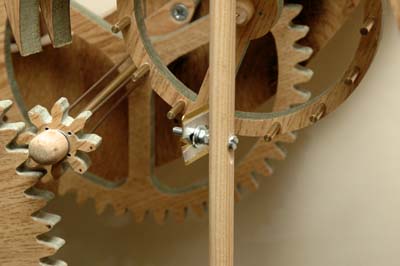 |
|
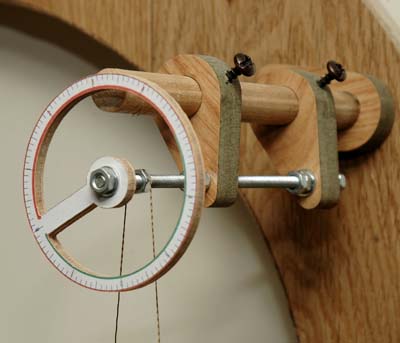 |
The distance between the verge and the crown wheel is absolutely
critical and the suspension point must be in line with the crown
arbor if the swing is to be the same each way. By allowing the
horizontal distance to be adjusted while the clock is running is
much better than having to stop it to move the verge weights, and I
think is more accurate. 0.02mm makes quite a difference.
With the exception of the drum elements and frame, the parts are
held together with pins and easily taken apart - should I wish to
try different ideas in the future!
It was also nice to have one 'wheel' with a single spoke, thus
completely the 4,3,2,1 layout. |
| The main weight of the verge is at the bottom to
stop the flapping that Clayton's design produces with just crescents
at the tops. It is elliptical to emphasis movement, not for
any weight consideration. These photos show the bottom weight at
the end of each swing and a laser marker to see the swing angle and
lateral movement - not quite a shafts worth. The temporary
paper is marked like a clock with 60 minute divisions.
I have a feeling that this is one of the main reasons the clock
is much more accurate than his.
One needs each complete turn of the wheels to be as consistent as
possible.
When I tested the accuracy/consistency of the clock every 6
minutes (one complete revolution of the 3rd wheel) it varied quite a
lot, but the main thing is that the variations repeated. If
the verge is flapping about this would add a random element to the
movement and thus the clock will be less accurate. |
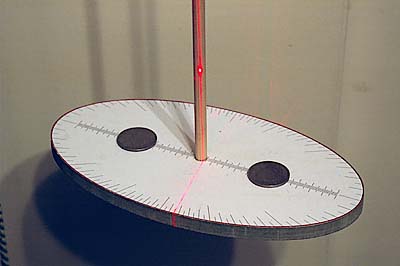
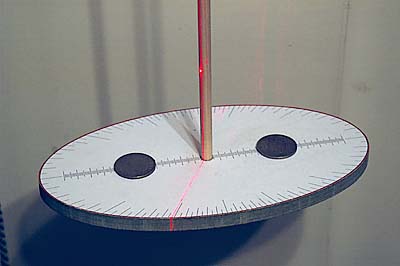 |
|




